| Clear
Creek State Forest, PA: Searching for American Chestnut |
Edward
Frank |
| Oct
07, 2005 19:55 PDT |
Clear
Creek State Forest, PA: Searching for American Chestnut
A famous poem, The Village Blacksmith (1841), by Henry Wadsworth
Longfellow begins:
Under a spreading chestnut-tree
The village smithy stands;
The days of the spreading chestnut in the Eastern United States
are gone. A fungal chestnut blight entered this country in New
York City in 1904. By the 1920's the disease had spread across
the range of the Chestnut and by the 1950's the American
Chestnut was all but extinct across its entire range. Formerly
it had grown throughout eastern United States with its area of
predominance running down a belt including New York,
Pennsylvania, West Virginia, Kentucky, and Tennessee, and
adjacent areas of adjoining states. In some forests the American
Chestnut made up at least 25% of the forest cover. Today it is
virtually gone.
These thoughts rolled through my mind as headed to Clear Creek
State Forest in west central Pennsylvania on a mission to
measure two American Chestnut trees actively producing nuts.
Generally the remnants of the trees are simply shrub sized
bushes grown from roots still living underground. These chestnut
sprouts are uncommon. Even less commonly the chestnut reaches
tree sized, and rarely do they reach reproductive maturity
before succumbing to the blight. The location
for these two trees were given to me by Gary Gilmore, a PA
Department of Conservation and Natural Resources, Bureau of
Forestry, Service Forester for this region. He is also active
with the American Chestnut Foundation. He wrote, "Last
Tuesday, we climbed these trees and harvested about 300 nuts
from each one. These nuts will then be used in the research to
develop blight resistant trees."
I was anxious to see them as we have few American Chestnuts in
our Eastern Native Tree Society database. The tallest reported
in Pennsylvania is located in Cook Forest State Park at a height
of only 75 feet. It was measured a couple months ago by Carl
Harting and was also producing chestnuts. http://www.nativetreesociety.org/fieldtrips/penna_cook_forest/two_trips_to_cook_forest.htm
Gary had emailed me GPS coordinates pulled from a GIS layer, but
hadn't verified them in the field. I translated the numbers to
the degrees and minutes with decimal format used by my GPS unit
and was off. The first tree was reported to be located along a
gas line road near the top of a hill amidst a patch of
blueberries. I drove past the turn-off to the next road and had
to turn around and head back to find the gas line road entrance.
I followed the directions and drove up the road the estimated
distance. I am glad I have good ground clearance in my Tracker.
I stopped and got out, and there was the tree. I was within 15
feet of its location - excellent directions. I took GPS
coordinates and then measured the tree. I had a several good
locations to measure the top of the tree along the road. The
bottom was obscured by blueberry bushes. I propped a stick
against the trunk and measured the top of the tree and the top
of the stick and calculated the height, and then added the
length of the stick to the base of the tree.
Lyle Summit #2 American Chestnut
cbh 46"
height 62.2 feet
|
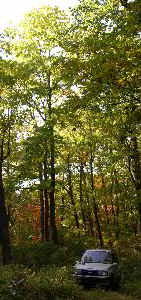
Lyle Summit #2 American Chestnut |
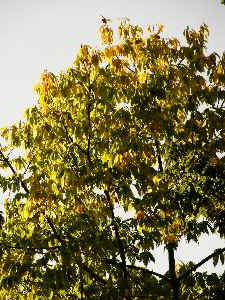
Top of Lyle Summit #2 American
Chestnut. A few nuts are still visible. |
From here I drove down to the next dirt road and headed up it a
short distance to the next tree. It is actually on the same
ridge about 1,700 feet from the first tree. I started out
following my GPS unit as it ticked off numbers. Then of course,
the batteries in the unit died. I cut across through the woods
back to the Tracker. I came across a couple smaller 30
foot-range chestnuts along the way. With new batteries found
rummaging in my glove compartment, I was off to find the tree.
The GPS coordinates I had been given were pretty good. The tree
was on the far side of a wire exclusion fence. It was obviously
bigger than the first tree I had visited. It was difficult to
find a good spot to see the top, but I finally found a good spot
to read. I measured the height from this one vantage point
through the trees along the trail.There was a pass through in
the fence some distance back, but I didn't feel like walking
that far. I didn't want to damage the fence by trying to climb
it. I am a relatively thin guy, so I found a place to squeeze
under the fence. Sliding under a stretched fence on your back
was rough enough, without the prickly chestnut shell digging
into my back as I slid. Anyway I made it. I measured the GPS
location and the circumference of the tree. The tree was 51.75
inches cbh - over four feet around! The results
were:
Lyle Summit #1
cbh 51.75"
height 71.98 feet (rounds to 72.0 feet)
|
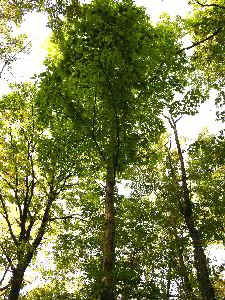
Lyle Summit #1 American Chestnut |
Both of these trees appeared to be healthy. I did not see signs
of blight, but as I am not an expert I could have missed them.
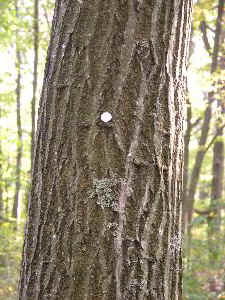
Bark on the lower section of the Lyle Summit #2
chestnut. The lower section of Lyle Summit #1 was
similar in texture. |
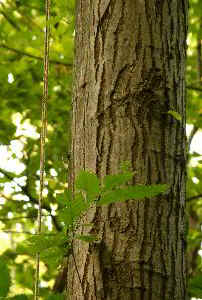
Smoother bark about 10 feet up the Lyle Summit #1
American Chestnut. |
In anticipation of finding these trees I had been busy on the
internet. The current National Champion Tree (American Forest
list) is in Washington State. It is a planted tree outside the
range of the blight. The figures for it are as follows:
American Chestnut Castanea dentata
Location: Washougal, WA
Circumference: 242 inches
Height: 77 feet
Spread: 77 feet
Points: 338
Most Recent Measurement: 2004
Nominator/s: Robert Van Pelt and Michael Dunn
This tree isn't that tall, but the impressive girth makes it the
National Champ. It is comparable in girth and height to the
large white oak on Lencer Drive just north of Cook Forest that
Carl Harting and I measured last month.
In the Eastern US the tallest in the listing, not including Carl
Harting's recent finds at Cook Forest, was in Massachusetts:
66.3' 2' 11.0" Mass. Mt.
Everett (0.4 mi. southeast of summit), Mt. Everett State
Reservation, Berkshire Co. Leverett & Wessels 5/26/02
On the ENTS website is a photo of a tree climber in an American
Chestnut
http://www.nativetreesociety.org/galleries/climbs/tree_climbs.htm
It reads :A recent climb for the American Chestnut Foundation.
The climber (Mike Riley, an employee) is ascending to do the
pollination. I had bagged the female flowers two weeks earlier.
He is nearing 40' up in this beautiful chestnut in Ashe County,
NC which may stand 60' tall. It is about 5 feet in girth and in
nearly perfect health. It has small non-lethal (yet?) cankers
only in narrow branch bark ridges. I will try to get a photo of
the impressive trunk of this tree. It is so smooth the bark
looks very much like young black birch or cherry. Photo by Will
Blozan.
A number of historical accounts of large chestnuts are listed in
"Great Eastern Trees Past and Present" by Colby Rucker
(2004)
http://www.nativetreesociety.org/bigtree/great_eastern_trees.htm
These accounts tell of a number of trees with great girths. One
listing stated: "North Carolina: American Chestnut. Joseph
S. Illick stated that a chestnut at Francis Cove, near
Waynesville, Haywood County, had a trunk diameter of seventeen
feet. This is considered the greatest known diameter of any
eastern hardwood." Several other accounts described trees
in the 8 to 12 foot diameter range. None of them talk about
great height. The tallest height mentioned in any of these accounts
was 75 feet.
Information on the American Chestnut Foundation website http://www.acf.org/
suggest that some chestnuts grew limb free up to 50 feet and
reached heights of 100 feet. But no height numbers are given for
any specific trees:
"And the trees could be giants. In virgin forests
throughout their range, mature chestnuts averaged up to five
feet in diameter and up to one hundred feet tall. Many specimens
of eight to ten feet in diameter were recorded, and there were
rumors of trees bigger still.... The tree was one of the best
for timber. It grew straight and often branch-free for 50 feet.
Loggers tell of loading entire railroad cars with boards cut
from just one tree. Straight-grained, lighter in weight than oak
and more easily worked, chestnut was as rot resistant as
redwood. It was used for virtually everything - telegraph poles,
railroad ties, shingles, paneling, fine furniture, musical
instruments, even pulp and plywood. "
The American Chestnut Foundation is working to produce a blight
resistant strain of chestnut by hybridizing American Chestnut
with resistant Chinese Chestnut, and then back breeding the
cross to retain the characteristics of the American Chestnut,
along with the resistance of the Chinese variety. I wonder what
the tallest American Chestnut is that they have found?
I can't find any reliable data (or even unreliable data)
indicating the height chestnut would reach in the past. It is
interesting that all of the American chestnut trees of
reproductive size today are relatively
short. Other tree species 80 years old may have reached 150 feet tall.
Many of the tall trees from GSMNP are secondary growth from
timbering operations 70- 80 years ago...
A nice overview of the history of the Chestnut and the blight is
available as a PDF file from Penn State: http://pubs.cas.psu.edu/FreePubs/pdfs/uh167.pdf
It is about 870kb in size and worth the download. The size
potential described in this 4 page pdf file is essentially that
the American Chestnut can reach 100 feet or more in height.
Another organization involved in trying to re-establish American
chestnuts is the American Chestnut Cooperators' Foundation http://ipm.ppws.vt.edu/griffin/accf.html.
The American Chestnut Cooperators' Foundation is trying to breed
a resistant chestnut using only American Chestnut strains and
perhaps augmenting this with other biological controls.
I believe we can find American Chestnut in the 80 foot range at
least somewhere in the Central Pennsylvania area. There are many
living smaller chestnut trees. We also have found several,
producing nuts, in the 60's and 70's in this area. An account of
another chestnut tree measured in the west-central PA was
published on the ENTS site last year:
http://www.nativetreesociety.org/fieldtrips/penna/chestnut/american_chestnut.htm
Tree dimensions were: cbh 3.9 feet, height 62 feet.
Scott Wade reported on an American Chestnut tree damaged by
climbing by a deer hunter with spikes in southeastern PA: http://www.nativetreesociety.org/fieldtrips/penna/se_pa_chestnut/se_pa_american_chestnut.htm
The tree dimensions were: 2'6 cbh x 64.1' tall with a 29' spread
So I am optimistic taller ones can be found. We just need to
concentrate on finding them. I will post photos to accompany
this trip report to the website.
Ed Frank
|
| RE:
Clear Creek State Forest, PA: Searching for American Chestnut |
Will
Blozan |
| Oct
08, 2005 09:23 PDT |
ED,
Great synopsis! I did a study in the Smokies to determine how
old the living
chestnuts were. They ranged in size from 2" to 16"
diameter. All were 39-42
years old in 1995. I fully expect a tree in the Smokies over 60'
but have
not yet measured any.
I have photos of a fallen tree I found in Greenbrier, TN GRSM
that was 22'
in girth and 125' tall to the discernable top. With bark and
sapwood the
tree would probably have been close to 25' in girth and over
130' tall.
Will B
|
| RE:
Clear Creek State Forest: American Chestnut |
Edward
Frank |
|
Oct
11, 2005 18:03 PDT |
ENTS,
I posted a couple questions to Gary Gilmore about the American
Chestnuts I
measured last week. He was part of the team that collected
chestnuts from
the tree in late September. Here are his comments:
Gary,
1) I found the two chestnuts. I will be doing a write up in the
next
couple days. I am wondering if these were trees you had
pollinated and
bagged earlier in the year?
Reply: "No, we were unable to access the top of the tree
until this year at
harvest time."
2) Was the tree producing any viable chestnuts without
artificial
pollination? Yes.
Reply, "There are other chestnuts around and the pollen
must travel far.
The problem we had getting nuts was due to the tree's perchance
for the bur
to open on the tree allowing the nuts to drop. Once they hit the
ground,
they are snatched up by rodents and gone."
4) To what degree do you think any potential regrowth of native
American
Chestnuts with some resistance to the blight is limited
by their being so spread out that pollination is difficult?
Reply, "As long as they get pollinated, I don't think there
is a problem.
The basic question is can the progeny from these trees live as
long ro
longer than their parent? That is one reason we are so anxious
to get their
"kids" to grow."
5) The GPS coordinates were within a few feet of the numbers you
gave me.
Reply, "Great, These were taken awhile ago but glad they
worked out. GPS is
really something!!!! Thanks for the "official
readings"
Ed Frank and Gary Gilmore
|
| RE:
Clear Creek State Forest: American Chestnut |
Carl
Harting |
| Oct
11, 2005 18:39 PDT |
Ed,
I think we should plan a measuring trip to the proposed Chestnut
Ridge
Wilderness Area in the northern section of the Allegheny
National Forest
next Spring. I've read that there's been good Chestnut
regeneration in
that area, so maybe we'll find some tall ones. Hopefully we can
get
some information about which part of the area contains the best
trees,
because it's big (about 5000 acres).
Carl
|
| Re:
Clear Creek State Forest, PA: Searching for American Chestnut |
Jess
Riddle |
| Oct
11, 2005 18:56 PDT |
Hi Ed,
Thanks for the summary of American chestnut finds, and the
measurements of the new trees. Judging from what you listed,
American
chestnut now fairs better in the Northeast than in the southern
Appalachians. The only 70'+ chestnut I've ever seen, a 76' tree
on
Shortoff Mountain near Highlands NC, died a few years after
being
measured.
By coincidence, last Sunday I measured the largest American
chestnut I
know of in north Georgia. The tree grows next to a Forest
Service
road on a ridge top at approximately 3200' elevation. The tree
is
severely infected with the blight, but continues to survive and
produce fruit. After some dieback, the tree stands at 43.9' tall
with
a circumference of 4'2" at 2.25' above the ground. At bh,
the trunk
is distorted by cankers.
Jess Riddle
|
|